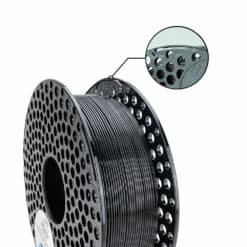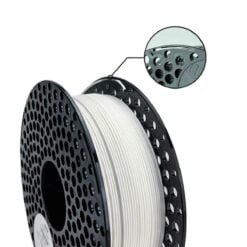PLA Prime

PLA Prime is our high-end engineering-grade PLA (Polylactic acid). Due to our enhanced formulation, PLA Prime has great heat resistance, high impact resistance and negligible shrinkage after annealing. The ease of use combined with the capability of high-speed printing and great interlayer adhesion, makes PLA Prime a reliable material that can handle the most intricate prints.
To know more about PLA Prime filaments, read our blog.
Printing recommendations:
- For the best results, print at 230–265°C*.
- Recommended printing bed temperature is 0-60°C. This material can be printed without an enclosure.
- We highly recommend using the thick and textured PEI sheets/glass, as the rigidity and strength of PLA Prime require the weight and/or magnetic pull of a high-quality printing bed.
*Ideal temperature may vary when using different printers.
Applications
PLA Prime is an excellent material for showcasing intricate designs, while also exhibiting durability and strength.
Prints easily like PLA, performs like ABS
Printing with PLA Prime is as easy as printing with regular PLA, and its excellent mechanical properties are similar to ABS. This makes PLA Prime a great material for creating functional objects/prototypes that need to withstand real-world circumstances, without the hassle of printing with regular ABS materials.
High heat resistance
Due to PLA Prime’s extraordinary heat resistance, it allows a much wider range of use than regular PLA. Where regular PLA wouldn’t be an option, PLA Prime is perfectly suited for items such as electronic casings, for which both high heat resistance and high impact resistance are required to protect the electronics inside.

High impact strength
The term ‘impact strength’ refers to the ability of a material to resist deformation, cracking and fracturing under sudden and intense impact. PLA Prime has a high impact strength, meaning it can resist a high amount of impact without influencing the integrity of your print.
Extremely low shrinkage (after annealing)
A common technique to enhance the strength and heat resistance of a printed object is called annealing. To anneal a 3D printed object is to heat the object to just above its crystallization level and allow it to cool down after, causing the print to become significantly stronger on a molecular level.
Annealing regular PLA often leads to deformation or even melting of an object. With our enhanced formula, PLA Prime has minimal shrinkage and deformation after annealing, so you can get the most precise yet strong prints possible.
To know more about annealing, read our blog.
High-precision printing with fine detail
PLA Prime offers the most aesthetically pleasing prints while showcasing the finest details of your design. The combination of high-precision printing and semi-matte look, which helps obfuscate layer lines, also makes PLA Prime the perfect material for architectural or artistic prints.

Perfect for high-speed printing
PLA Prime is perfect for high-speed printing (≤300mm/s) while leaving its mechanical properties uncompromised. This allows you to print at high speed, without having to worry about its possible effects on the end result.

Excellent interlayer adhesion
PLA Prime has excellent interlayer adhesion, an attribute that is crucial for ensuring the structural integrity and strength of printed parts. Good interlayer adhesion minimizes the risk of cracking under pressure and creates a smoother printing process.

Product Storage
We recommend storing the filament in a cool, dry enclosed space with a silica desiccant packet, away from UV light.
Features & Properties
| Standard | XY Value | XZ Value | ZX Value | Unit | |
|---|---|---|---|---|---|
| Tensile Strength | ISO 527-2 | 27.8 | 31.4 | 14.2 | MPa |
| Yield Strength | ISO 527-2 | 26.1 | 29.7 | 14.5 | MPa |
| Tensile Modulus | ISO 527-2 | 2400 | 2600 | 1900 | MPa |
| Strain at Yield | ISO 527-2 | 4.3 | 6.5 | 0.9 | % |
| Flexural Strength | ISO 178 | 52.3 | 56.4 | 3.0 | MPa |
| Flexural Modus | ISO 178 | 2600 | 3000 | 1800 | MPa |
| Impact Strength | ISO 179 | 21.5 | / | / | kJ/m² |
You can access the Technical Data Sheet and Safety Data Sheet here.

























